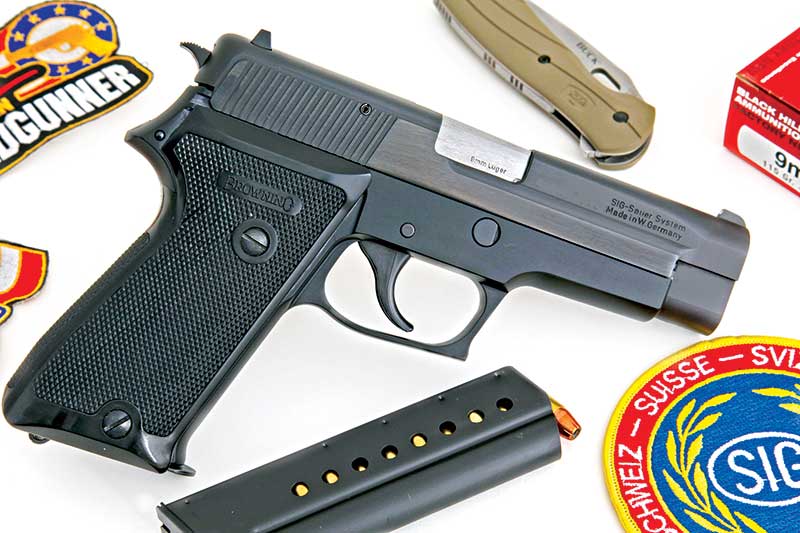DA Semi-Autos
Good, bad — Or indifferent?
It’s been 90 years since Walther made what’s generally considered the first commercially successful DA semi-auto pistol, the model PP. Most previous semi-autos were single-action designs in which the hammer or striker had to be cocked as a separate step before firing. The Walther PP and the many similar designs of the last 90 years are currently referred to as “traditional” double actions. With these designs the hammer is cocked as the slide is racked to chamber a cartridge. Depressing a decocking lever (located on either slide or frame) then drops the hammer to a de-cocked position.
With the PP design the decocking lever remains down and serves as an additional safety until manually flipped up again, also letting the trigger return to its full forward position. With some later designs the lever is spring-loaded so it acts only as a decocker, not as a safety device.
Carried with chamber loaded, hammer down and trigger in its forward position, the DA semiauto can be fired with one long heavy pull on the trigger, similar to the DA pull of a revolver. After the first shot it functions like any other semi-auto pistol, with the hammer cocked by the slide as the action cycles, and subsequent shots fired by a short, lighter trigger press.
All the designs, safety devices, levers and carrying options are attempts to solve a basic conundrum — how to keep the pistol as secure as possible from being fired unintentionally. At the same time, however, it has to be fired accurately and quickly if needed. Circa 1930 the issue was actually quite well addressed by the DA revolver.
With popular models such as the S&W Military & Police and the Colt Official Police, the revolver required a long, fairly heavy (10+ lbs.), deliberate trigger pull in order to fire. Yet in the face of an imminent threat, you simply point gun — pull trigger.
Coins
But many people simply do not feel comfortable carrying cocked-and-locked. There’s also the concern about the relatively light, short trigger press of a cocked pistol at a time when the stress level is high. The DA semi-auto addresses these issues with its hammer-down carry mode and long, heavy first shot trigger pull. The first shot offers the same speed and simplicity as the DA revolver with no safety to release or fumbling. Point gun — pull trigger.
Some early DA semi-autos had very heavy DA pulls. I own Walther PP and PPK pistols (including a pre-war PPK), have tested others and have never seen one with a decent DA pull. Wartime P38’s typically had a very heavy DA pull and as a result many shooters of the post-war era took a dim view of the whole concept. Current DA semi-autos by makers such as Beretta, CZ, HK, Ruger, Smith & Wesson and others are very good. We all have our favorites and mine is the SIG-SAUER P220 series. Not only are these high-quality and accurate pistols, the DA pulls are smooth, reasonably light and consistent.
The big objection to traditional DA designs is the transition from a long, heavy first-shot trigger pull to a short, lighter pull for subsequent shots. According to some this is an insurmountable obstacle. If the grip and finger position on the trigger is right for the DA pull, they say, it’s wrong for the SA press. Others say the DA pull is so heavy as to make first-shot hits impossible. Some have even suggested firing off the first shot into the air just to get the gun cocked. Right, run the idea past a lawyer and see what the response is — and no, don’t do it.
Pros
Such objections may have had merit back in the 1940s when DA semi-autos often had DA pulls of 15 or 20 lbs. Although most of my shooting is with SA semiautos, I do shoot DA semiautos, not to mention GLOCKs and similar designs, plus single- and double-action revolvers. Frankly I just don’t see it’s so terribly difficult. I can also drive cars, tractors, trucks, automatic and manual transmissions, motorcycles, ATVs and boats and I’m certainly no great athlete.
Traditional DA semi-autos would not be my first choice for competition, but competition is not what interests most handgunners. What they want — and need — are threat management tools. They don’t want to shoot themselves, their loved ones, their co-workers or passersby. They would much prefer an assailant surrender or go away, but if they must shoot they want to hit. For many individuals and police agencies, the traditional DA semi-auto ticks the most boxes.






